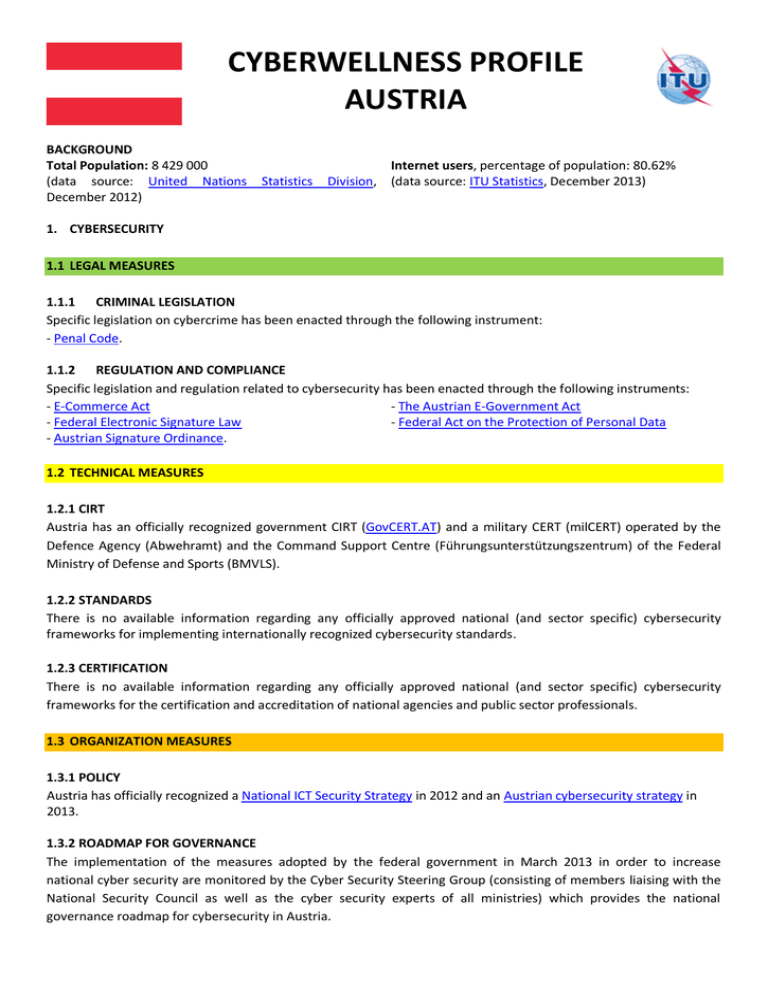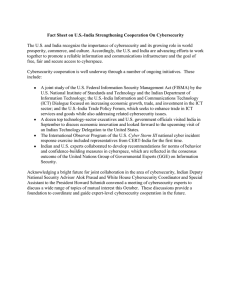CYBERWELLNESS PROFILE AUSTRIA
advertisement

CYBERWELLNESS PROFILE AUSTRIA BACKGROUND Total Population: 8 429 000 (data source: United Nations December 2012) Statistics Internet users, percentage of population: 80.62% Division, (data source: ITU Statistics, December 2013) 1. CYBERSECURITY 1.1 LEGAL MEASURES 1.1.1 CRIMINAL LEGISLATION Specific legislation on cybercrime has been enacted through the following instrument: - Penal Code. 1.1.2 REGULATION AND COMPLIANCE Specific legislation and regulation related to cybersecurity has been enacted through the following instruments: - E-Commerce Act - The Austrian E-Government Act - Federal Electronic Signature Law - Federal Act on the Protection of Personal Data - Austrian Signature Ordinance. 1.2 TECHNICAL MEASURES 1.2.1 CIRT Austria has an officially recognized government CIRT (GovCERT.AT) and a military CERT (milCERT) operated by the Defence Agency (Abwehramt) and the Command Support Centre (Führungsunterstützungszentrum) of the Federal Ministry of Defense and Sports (BMVLS). 1.2.2 STANDARDS There is no available information regarding any officially approved national (and sector specific) cybersecurity frameworks for implementing internationally recognized cybersecurity standards. 1.2.3 CERTIFICATION There is no available information regarding any officially approved national (and sector specific) cybersecurity frameworks for the certification and accreditation of national agencies and public sector professionals. 1.3 ORGANIZATION MEASURES 1.3.1 POLICY Austria has officially recognized a National ICT Security Strategy in 2012 and an Austrian cybersecurity strategy in 2013. 1.3.2 ROADMAP FOR GOVERNANCE The implementation of the measures adopted by the federal government in March 2013 in order to increase national cyber security are monitored by the Cyber Security Steering Group (consisting of members liaising with the National Security Council as well as the cyber security experts of all ministries) which provides the national governance roadmap for cybersecurity in Austria. 1.3.3 RESPONSIBLE AGENCY The Cybersecurity Steering Group and the Cyber Crime Competence Center (C4) of the Federal Ministry of the Interior (BM.I) are the national coordination and reporting bodies for combating cybercrime and the officially recognized agencies responsible for implementing a national cybersecurity strategy, policy and roadmap in Austria. 1.3.4 NATIONAL BENCHMARKING Every year the government publishes a cybersecurity report used to measure cybersecurity development in Austria. 1.4 CAPACITY BUILDING 1.4.1 STANDARDISATION DEVELOPMENT The Austrian IT Security Handbook contributes to the research and development (R&D) program/project for cybersecurity standards, best practices and guidelines to be applied in either the private or the public sector. Also the Austrian security research funding program (KIRAS) is a national program to promote safety research in Austria. KIRAS supports national research projects with the aim of increasing the security of Austria and its people. 1.4.2 MANPOWER DEVELOPMENT The European Cybersecurity Month in Austria provides educational and professional training programs for raising awareness with the general public, promoting cybersecurity courses in higher education and promoting certification of professionals in either the public or the private sectors. 1.4.3 PROFESSIONAL CERTIFICATION There is no available information regarding the exact number of public sector professionals certified under internationally recognized certification programs in cybersecurity. 1.4.4 AGENCY CERTIFICATION The number of certificates accredited by national accredited bodies against ISO/IEC 27001 was 28 in 2012. 1.5 COOPERATION 1.5.1 INTRA-STATE COOPERATION To facilitate sharing of cybersecurity assets across borders or with other nation states, Austria has officially recognized partnerships with the following organizations: -Coalition Warrior Interoperability eXploration, eXperimentation, eXamination, eXercise (CWIX) - The exercise held in Poland in June 2013 provided an opportunity to perform technical and operational tests with deployment-oriented systems, services and applications. - Cybersecurity Platform (CECSP) was founded in May 2013 on the initiative of Austria and the Czech Republic and aims to enable the information, best practices, lessons learned and know-how sharing about cyber threats and potential or (un)successfully carried out cyber-attacks. 1.5.2 INTRA-AGENCY COOPERATION The ICT Security Portal is a measure defined in the Austrian Cybersecurity Strategy and is officially recognized as the national or sector-specific program for sharing cybersecurity assets within the public sector. It was launched as an inter-ministerial initiative in cooperation with the Austrian economy. The aim of the Web platform, which went online in 2013, is to raise awareness and it serves as a valuable source for information and communication for different target groups. 1.5.3 PUBLIC SECTOR PARTNERSHIP Austria has officially recognized the following national or sector-specific programs for sharing cybersecurity assets within the public and private sector. - The Private Public Partnership Program for Critical Infrastructure Protection (APCIP) with the objective to develop a comprehensive strategy and detailed measures and to bring all relevant public and private organizations and infrastructure operators under one common conceptual roof. -The CERT Alliance which enhances cooperation of Austrian CERTs in the public as well as the private sector. Its aim is to bundle available resources and to use the joint know-how optimally in order to ensure maximum ICT security. - The Austrian Trust Circle (ATC) founded in 2010 is an initiative of GovCERT.AT and the Federal Chancellery in order to build confidence between the responsible persons and organizations in individual sectors of strategic infrastructures so as to facilitate the exchange of security-related experience and ensure that swift and joint action will be taken in concrete cases. 1.5.4 INTERNATIONAL COOPERATION Austria is a member of the ITU-IMPACT initiative and has access to relevant cybersecurity services. To facilitate sharing of cybersecurity assets across borders or with other nation states, Austria has officially recognized partnerships with the following organizations: - UN - NATO - EU - OSCE - ENISA - FIRST - Trusted Introducer - The European Forum for Member States (EFMS) - Participation in NATO exercise Cyber Coalition 2013. 2. CHILD ONLINE PROTECTION 2.1 NATIONAL LEGISLATION AND STRATEGY Specific legislation on child online protection has been enacted through the following instruments: - §64(1)4a and §207a* of the Criminal Code. - Law on Obscene Publications and on the fight to protect the youth against moral hazard*. The National ICT Strategy Austria considers campaigning on a social media guide for parent in its objective of awareness-raising. 2.2 UN CONVENTION AND PROTOCOL Austria has acceded, with no declarations or reservations to articles 16, 17(e) and 34(c), to the Convention on the Rights of the Child. Austria has acceded, with no declarations or reservations to articles 2 and 3, to the Optional Protocol to The Convention on the Rights of the Child on the Sale of Children, Child Prostitution and Child Pornography. 2.3 INSTITUTIONAL SUPPORT The Computer Emergency Response Team of Austria (CERT.at (*)) does not provide specific information on child online protection. 2.4 REPORTING MECHANISM Illegal online content can be reported at www.stopline.at (*). ----------------------------------------------------------------------------------------------------------------------------------------------------------DISCLAIMER: Please refer to http://www.itu.int/en/Pages/copyright.aspx More information is available on ITU website at http://www.itu.int/en/ITU-D/Cybersecurity/Pages/default.aspx Last updated on 22th January 2015

